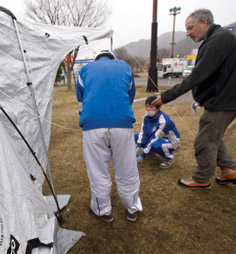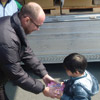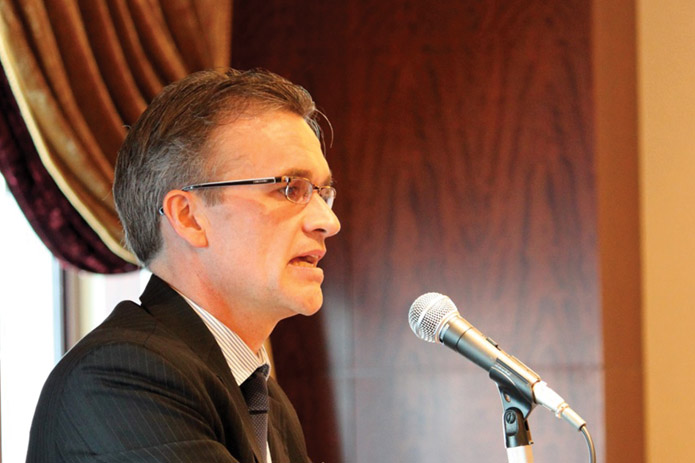The UK was among the first of about 100 countries to offer help after the Great Tohoku-Kanto Earthquake struck on 11 March. Here is the harrowing story of how three innovative British aid agencies made a difference, written and photographed by two of the first witnesses of the aftermath.
The first of the distinctive green boxes are heaved down from the back of the truck and manhandled by ShelterBox staff alongside a hedge that marks the edge of Kamaishi City’s Chuo Park. Ten days ago, children on bikes would have been playing here as parents steered infants’ pushchairs alongside the river.

Light and strong tents with groundsheets can take 10 people
The Great Tohoku-Kanto Earthquake devastated this previously peaceful little community on the coast of Iwate Prefecture, the tsunami surge wrecking the waterfront district and leaving the Rikuchu-Kaigan Grand Hotel on the seafront a shell. The water roared through the ground floor of the building but upper floors managed to escape the worst of the destruction. And with shelter and warmth at a premium—patches of snow litter the ground, there is a stinging rain in the air, and the temperature can only be a fraction above zero—a number of families have moved into what remains of the building.
Such is the desperation of many people in north-east Japan. And where there is desperation, there are British charities and volunteers.
“We assessed the situation initially when we arrived in Japan and I would say this is one of the worst disasters that I have ever seen”, said John Diksa, who was leading the ShelterBox team dispatched to Kamaishi. “I’ve been in Haiti and Indonesia recently and now, unfortunately, I’m here in Japan.
“Our equipment is designed to keep people warm and dry”, he said. “It is raining now and will probably be snowing later; people are tired, they are eating badly and some of them are in shock. For many of these people, their bodies will simply not be able to cope. We want to make sure they stay warm, dry and happy despite all that they have been through”.
ShelterBoxes are an ingenious concept dreamed up by Tom Henderson, a Rotarian and former Royal Navy search and rescue diver. Henderson realised that the aid response to most disasters was in the form of food and medicine to help people survive the initial aftermath of a disaster. There was, however, little or no help in terms of shelter for survivors through the critical first few days and beyond as they tried to rebuild their lives.
ShelterBox was launched in April 2000, with the Rotary Club of Helston-Lizard in Cornwall adopting the scheme as its millennium project. The first consignment of 143 boxes went to victims of the earthquake in the Indian state of Gujarat, in January 2001; by the end of 2004, nearly 2,600 had had been dispatched to various disaster zones and regions of conflict around the world.
The devastating Indian Ocean tsunami of December 2004 posed the most significant challenge to the organisation, but the response was an influx of volunteers and the scale of operations being ramped up dramatically. In 2005, more than 22,000 boxes were sent out, to victims of the tsunami as well as to the people who had lost their homes in Hurricane Katrina in the southern states of the US, and in response to a huge earthquake in the Kashmir region of Pakistan.

ShelterBoxes contain tents, groundsheets, blankets, clothes, cooking utensils, tools, water equipment, and a children’s pack
Like all of the organisation’s volunteers and staff, Diksa is clearly a can-do sort of person.
The boxes are not being unloaded quickly enough for his liking and he immediately ropes in a group of youngsters from a local football team who had been watching. Instantly, he has them working in pairs to stack the boxes and—before they can slope off—he opens one of the boxes and organises them into erecting the tent.
Wearing a woolly Liverpool FC hat, 15-year-old Shuto Ichida looks more than a little dubious as the silver tent is laid out on the ground and the flexible poles are unpacked, but he is soon following Diksa’s orders.
“We were lucky because our house was away from the water and it was only slightly damaged in the earthquake and my parents and my younger sister are all okay”, he said.
“I’m not sure if I would like to stay in one of these for very long”, he says with a nod towards the tent as it lies deflated on the ground, but as it is raised into its distinctive dome shape, the inner shell is attached and the ground sheet put in place, he changes his mind.
“I think it will be useful for people who have lost their homes”, he said. “It is much better than having nothing at all and there are plenty of people who could use these in this town”.
Within days of the earthquake and tsunami striking Japan, 600 boxes had been transported from Helston to Japan and another 1,000 were on their way, said Lasse Peterson, the Brisbane-based international director of ShelterBox. The boxes were flown to Japan for free by Virgin Atlantic Airways.
“Last year we helped out in 25 disasters in 25 countries, from cyclones in Madagascar to floods in Peru and Bolivia, and our aim is simply to get this equipment to those who need it most, whether that be families, emergency workers, doctors or orphans”, he said. “I’d say that 97 percent of what we do is in developing countries; this is the first time we have had to operate in Japan.
“We didn’t know much about the emergency response situation in Japan before this happened, but we have been amazed at how good it is”, he said. “But there are still gaps in the system and if we can help fill those gaps, then great”.

Japan cooperation Agency senior advisor Dr. Babi Hitoshi has been working with MapAction in Tokyo
Each town also has its temporary morgue, where the dead are laid out—sometimes in wooden boxes, but often just wrapped in plastic sheeting on the floor. Red-eyed relatives accompany some of the bodies; others arrive distraught too try to find a missing family member.
The police chief of Miyagi Prefecture said on 20 March that they were expecting 1,000 bodies to be washed ashore every day. Crematoria will struggle to deal with that number of corpses.
“Given the utter devastation of many coastal areas of Miyagi Prefecture, the number of dead were always going to be in the thousands”, said Ian Woolverton, an aid worker with Save the Children. “In places where there were once schools and playgrounds there is little left standing—just a mess of timber and masonry.
“Children here who have survived have lost family and friends and risk being deeply damaged by what they have been through unless they are given the right support to recover”, he said. “It will take families who have survived a long time to get over this. It is crucial that we are here to help them”.
In Ishinomaki, Kama Elementary School has been turned into a haven of safety and relative serenity for dozens of local people, including about 30 children whose parents were lost in the tsunami—in some cases swept away before their eyes.
These children are quieter than those who have been reunited with their families; they play cards or read, watched over carefully by teachers or relatives. Understandably, journalists are not allowed to talk to them as their minders do not want them reminded of the disaster that has befallen them. The sound of a door sliding open behind them might also raise their hopes that their parents have arrived to take them home.
There are hundreds of such refugee centres in towns the length of the northeast coast. There will be thousands of children scarred by these twin disasters.
The charity was quick to begin child-protection activities in areas affected by the earthquake and tsunami, as well as to distribute blankets to stave off the cold.
“What we’ve seen over the past few days has convinced us of the need to expand the work we are doing”, said Stephen McDonald, head of the team in Japan. “We’ve seen children suffering with the cold and lacking really basic items like food and clean water. Tomorrow we are giving out blankets and our team in Tokyo is looking into what other goods we can supply.
“As we push up the coastline from Sendai, we are finding pockets of profound humanitarian need and we’re going to do everything we can to meet them while remaining focused on our child protection work”.
The decision to expand into relief distribution was made after exploratory missions north of Sendai revealed the extent of the difficulties faced by families displaced by the earthquake. Teams found shortages of essential items, such as food, water, cooking fuel and clothing, at a time when freezing weather conditions were predicted.
“As humanitarian workers, we have to be flexible and respond to what we see on the ground”, said McDonald. “The key to any successful humanitarian response is the ability to react to the situation as we find it”.
A third British charity engaged in relief work has been MapAction, which uses the latest technology, particularly geographical information systems (GIS) and satellites, along with information gathered from the scene of the disaster, to provide updated maps that give emergency rescue teams, relief and aid workers an accurate picture of the situation they are facing.
This might mean enabling those trying to deliver aid to see which bridges have been destroyed and which roads have been made impassable, and then determine the best way to get help to where it is needed.
Alternatively, as was the case following the Haiti earthquake, information provided by MapAction can help search and rescue teams locate people trapped by collapsed buildings; it identifies locations from which are coming mobile phone calls for help.
Standing at the top of the valley that used to be home to the villagers of Minami Sanriku, it is utterly clear that the work these charities are doing is desperately needed. And their support will be needed for many years to come before the Tohoku region can get back on its feet.
To donate, volunteer or support:
ShelterBox
Save The Children
MapAction






